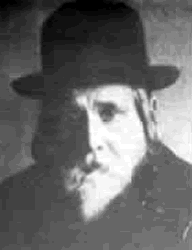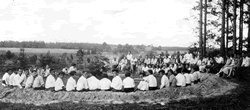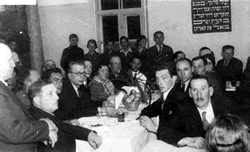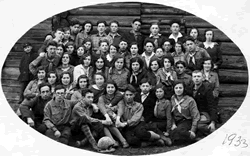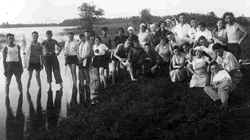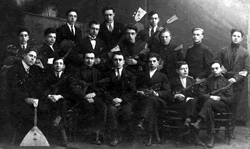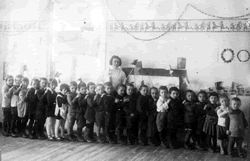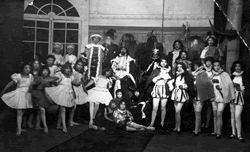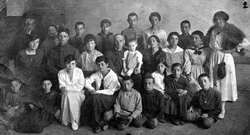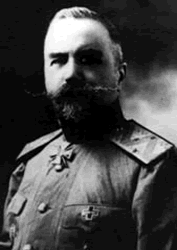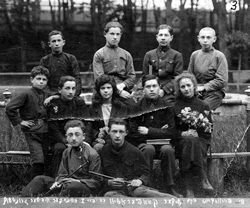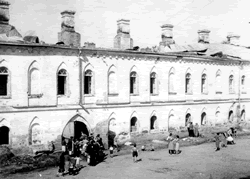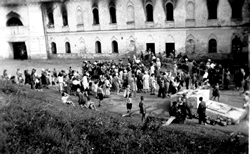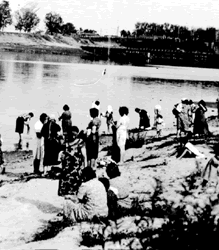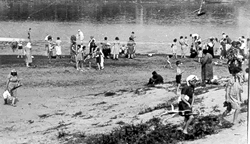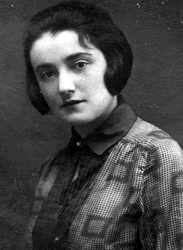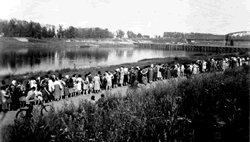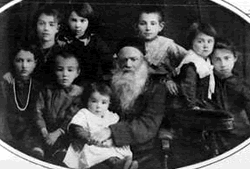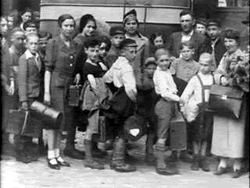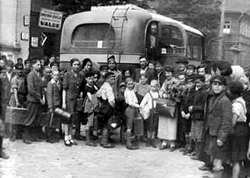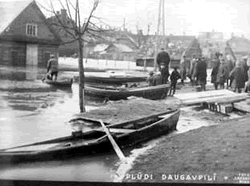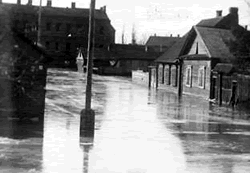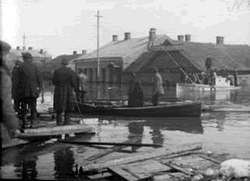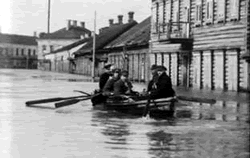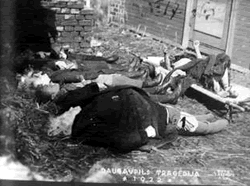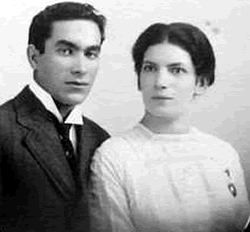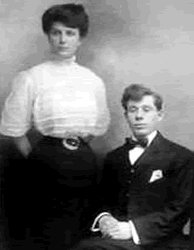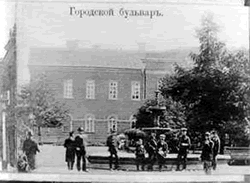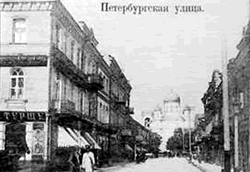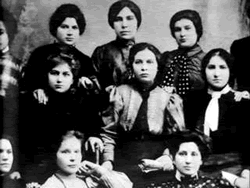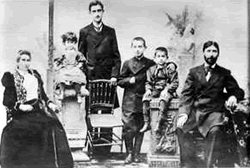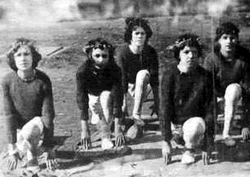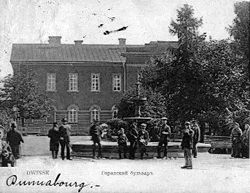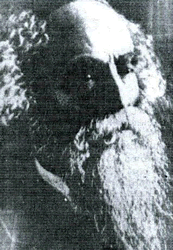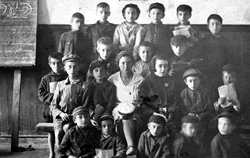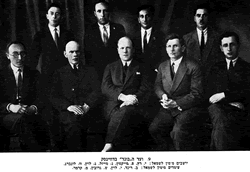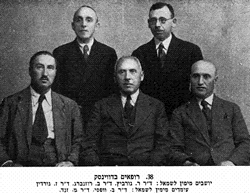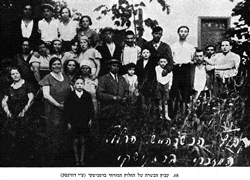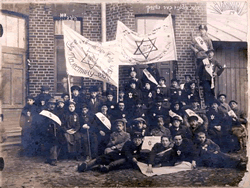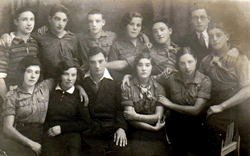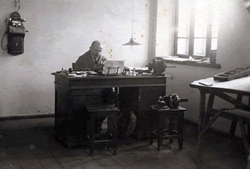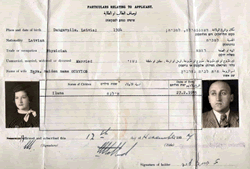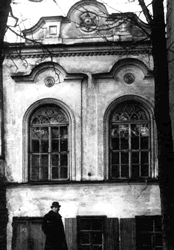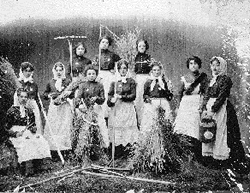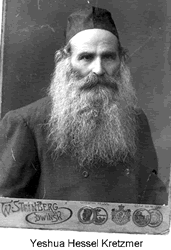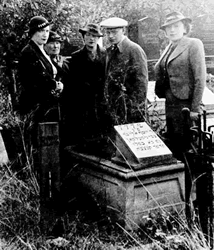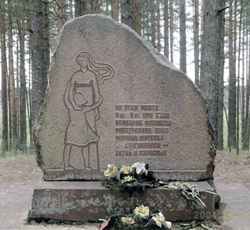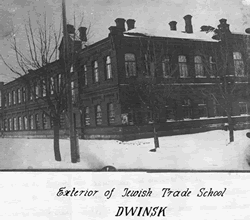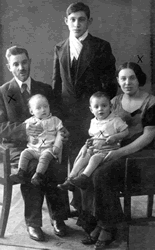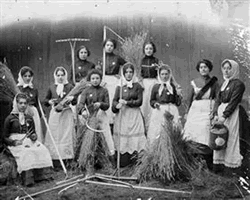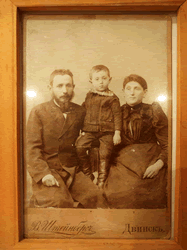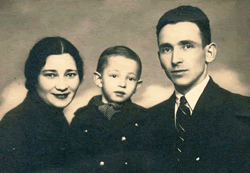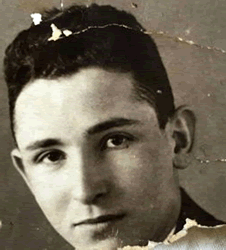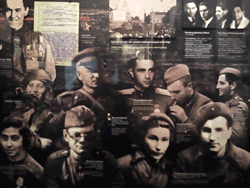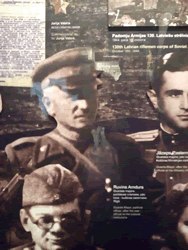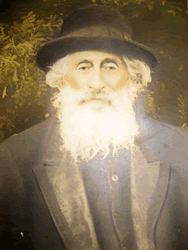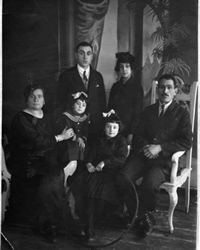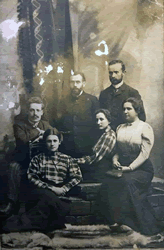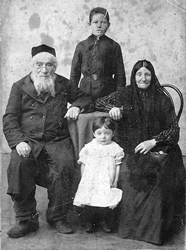Dvinsk- Dwinsk- also known as Denenburg, Russia, known now as Daugavplis, Latvia
55.53N 26.32E
|
#dv-1: Meir Simcha of Dvinsk (1843-1926) was a rabbi and prominent leader of Orthodox Judaism in Eastern Europe in the early 20th century. |
#dv-2:. A nature activity for members of the Borochov Yugnt youth movement in Daugavpils |
#dv-3: A celebration inaugurating the dormitory center "Ma'on ha - Olim" in Daugavpils (Dvinsk). Before World War II |
|
#dv-4: A meeting of members of "Galil Gimel," Dvinsk district of the youth movement Netsach (Pioneer Scouting Youth |
#dv-5: |
#dv-6: A balalaika ensemble in Daugavpils (Dvinsk), Latvia, photographed in 1929 or 1930. |
|
#dv-7: A Jewish kindergarten in Daugavpils (Dvinsk), Latvia in the late 1920s. |
#dv-8: Participants in a show entitled "Boom un Dreydl," staged by pupils of the Yiddish school in Daugavpils (Dvinsk). |
#dv-9: Pupils and teachers of the first Yiddish school in Daugavpils (Dvinsk). |
|
#dv-10: General Evgenii Miller |
#dv-11: Students in the Yiddish school in Daugavpils (Dvinsk), who set up a cooperative for providing tutoring for needy pupils. |
#dv-12: Jews taken from the Dvinsk ghetto and assembled prior to their extermination in c 1942 |
#dv-13: Jews taken from the dvinsk ghetto prior to their extermination. |
#dv-14: Jewish children and women of Dvinsk abused and forced by the Germans to bathe in the cold river 1941-1942 |
#dv-15: Jewish women and children forced by the Germans to bathe in the cold river |
|
#dv-16: Golda - Genia Chaikin, a kindergarten teacher and schoolteacher from Daugavpils (Dvinsk), Latvia. |
#dv-17: A pupil of the Yiddish school in Daugavpils (Dvinsk), who took part in a show entitled "Boom un Dreydl," staged by the pupils. |
#dv-18: Jewish women and children in Daugavpils (Dvinsk), Latvia, who were forced by the Germans to bathe in the cold river during the Holocaust. |
|
#dv-19: pub. Dec. 14, 1924 Daugavpils/ Dvinsk |
#dv-20: Summer 1938/Daugavpils |
#dv-21: group of children from Daugavpils with their parents depart for the OZE (Society for the Protection of the Health of the Jews) Aronson summer camp in Striap 1938. |
|
#dv-22: 1922 Daugavpils; After the flood |
#dv-23: 1922 ; Daugavpils After the flood. |
#dv-24: 1922. By The Drugstore after the flood |
#dv-25: The year 1922; Dvinsk after the flood |
#dv-26: Corpses laid out on straw-covered ground after the flood of 1922 in Dvinsk. |
#dv-27: Joseph and Rosa Sosin of Dvinsk c 1920 |
#dv-28: Scheva (left) and Lijas Neisloss (Neisxloss), c1910 |
#dv-29: |
#dv-30: View of Petersburg Street, Dvinsk: a policeman and another man pose on the corner of a street of shops, 1908 |
#dv-31: Studio portrait of a group of young Jewish women, revolutionaries c. 1905. "They are all in America now" (From a 'Jewish Daily Forward' photo essay, 1932: "Jewish Revolutionaries Of The Past. |
#dv-32: 1903 "A modern family in the old country... Yeshaye Bloch, a well-known lawyer... his wife and children. This picture was sent in by Mrs. Rose Weinberg, of Detroit." (From a 'Forward' photo essay, 1933: "...The Vogues Of Yesteryear...") |
#dv-33: pub. April 8, 1923 Physical exercise in a public school in Dvinsk; Jewish Daily Forward |
| #dv-34: 1908, Dvinsk. Klive Moss site for Dvinsk; |
#dv-35: the Rogachaver Gaon, Rabbi Yosef Ruzin |
#dv-36: Pupils and teachers of the first Yiddish school in Daugavpils (Dvinsk). |
#dv-37: |
#dv-38: |
#dv-39: Kibbutz Hachshara ( training camp) of "HaChalutz Mizrachi" near Dvinsk |
#dv-40: Dvinsk, 1917; Dave ( my father) and Jack PoKempner standing on the |
#dv-41: Sara Ziskovich? Zuskovits? (bottom row 1st on left), born 1915, moved Alma Hall alma_hall@mac.c.. |
#dv-42: Levitan, the principal of an ORT vocational school in Dvinsk |
#dv-43: |
#dv-44: Latvia DAUGAVPILS Malkiel's SYNAGOGUE |
#dv-45: Members of "Daughters of Zion" organization, Dvinsk, Russia, 1904. Labor Archives, Lavon Institute, Tel Aviv |
#dv-46: Yoshua Hessel Kretchmer |
#dv-47: From left; Roza Iss ( 1902 Riga- 1941 murdered by the Nazis), Gittel Nisselson (nee Jewelsohn 1880 Dvinsk- 1978 Israel) , Raitze Nisselson, Mane Nisselson, Scheina Armerman and Leiser Lurie at the grave of Josiph Nisselson |
#dv-48: A memorial to those who perished |
#dv-49: |
#dv-50: Ida Nekhom nee Volkin |
#dv-51: Members of Daughters of Zion, a women’s Zionist organization, Dvinsk, Russia (now Daugavpils, Lat.), 1904. (The Institute for Labour Research in Memory of Pinchas Lavon, Tel Aviv) |
#dv-52: Ilana Baird wrote; My ggfather Meilach Moshe (Moisei) and his parents Abraham and Sara - where from Dvinsk Latvia. |
#dv-53: Esther nee Ravdina Zeldin-Cimerman, David Zeldin and their son Mendel' |
#dv-54: Moisey Zeldin was born in Dvinsk, Latvia in 1905 to Isocher and Hasia nee Yonin. He was single. Prior to WWII he lived in Latvia. During the war he was in Latvia. Moisey was murdered in the Shoah. This information is based on a Page of Testimony submitted by his nephew, Eli Rabinowitz |
#dv-55: |
#dv-56: |
#dv-57: Mary Dworetz |
#dv-58: Mary Dworetz, Jehoshua Zelik Goldin, Shora-Rivka (Sarah) Goldin, Minnie Diamond, Chaya Goldin, Chaikel Goldin |
#dv-59: The couple on the left is Abo Ichlov and his wife, Rivka Kenigsberg. We know they came from Dvinsk and were married there in 1907. They became active in the Bund, and sometime after their marriage, moved away from Dvinsk. (Maybe to Saratov and Moscow, but I’m not sure.) They both died between 1918 and 1922. Submitted by Gale Marcus. |
#dv-60: These are definitely Ospovat/Ospowat - Icnlov family members. Taken in Dvinsk, Latvia .Possibly Gershen and Golda Ospovat.......but they look like the grandparents of the two children, so it could possibly be Haim and Rivka Ospovat https://ospovat-ichlove-beck-family.weebly.com/ospovat-ichlov-tree.html |
|
|
|
Please share your comments or photos or links for posting on our Guestbook Page here: egl.comments@gmail.com
LINKS
The Columbia Electronic Encyclopedia®
The Jewish Families of Dvinsk;
http://www.jewishgen.org/databases/latvia/DvinskFamilies.htm
Dvinsk (now Daugavpils, Latvia) ;
http://daugavpils.latviasig.org/
Latvia database;
http://www.jewishgen.org/databases/latvia/
A Latvian site;
http://www.daugavpils.lv/
http://www.jewishencyclopedia.com/view.jsp?artid=540&letter=D
By : Herman Rosenthal S. Janovsky
City in the government of Vitebsk, Russia. It is situated on the River
Düna, at the intersection of two railroads. It was founded in 1278 by
the Knights of the Livonian Order, and in 1561 was annexed to Poland.
According to the census of 1897 it has a population of 72,231, the
Jews numbering 32,369. The latter are engaged in commerce, industries,
and manufacturing. The local trade is entirely in their hands, and the
chief articles of commerce are flax, flaxseed, and timber. Toward the
end of the last century the business transactions amounted to ten
millions of rubles annually.
Industrial occupations are also left almost entirely to the Jews.
According to the official census of industries made in 1893, there
were in Dvinsk 330 industrial establishments owned by Jews, and 99
owned by non-Jews, while the number of Jewish artisans was only 741.
As a matter of fact both the absolute and the relative number of
Jewish artisans is much greater. According to a private investigation
in 1898 there were 4,862 Jewish artisans, including 2,193 masters,
1,760 journeymen, and 909 apprentices.
The most important of the trades followed by the Jews are tailoring
(1,210) and shoemaking. In the 32 local factories and workshops (match
factory, tannery, sawmill, button factory, etc.), all owned by Jews,
there is a total of 2,305 employees, of whom 1,942 are Jews. There are
in Dvinsk 658 Jewish day-laborers.
Taking the average family as consisting of five persons, it appears
that in 1898 thirty per cent of the Jewish population of Dvinsk
applied for aid from the community. The help given to poor and
destitute Jews comes from a savings and lending association, and from
various charitable institutions. The first of these, founded in 1900,
was established as a mutual aid society. It has more than 1,200
members, and lent in 1902 (up to Sept. 1) various small sums, ranging
from 15 to 50 rubles, and aggregating 41,321 rubles. There is another
organization, established on charitable principles, for the
advancement of small loans. This is a loan fund of 13,000 rubles
founded in memory of M. Vitenberg. Loans, secured by personal
property, are advanced without interest. Of other charitable
institutions there are a society for aiding the poor, founded by the
governor, with an income in 1899 of 8,917 rubles; a cheap dining-hall;
a biḳḳur ḥolim; a dispensary; and a lying-in hospital.
In the year 1898, in the general schools of Dvinsk there were 1,203
pupils, 359 of them being Jews. In the schools exclusively Jewish
there were 401 pupils. The attendance in the general schools was as
follows: scientific high school, non-Jews 344, Jews 36; girls'
classical high school, non-Jews 240, Jews 140; city school, containing
industrial classes, non-Jews 151, Jews 74; private four-class girls'
school, non-Jews 73, Jews 76; one-class girls' school, non-Jews 36,
Jews 33.
In the Jewish schools: Talmud Torah, 122; Jewish school, with
preparatory class, 116; three-class Jewish industrial school, 87;
private Jewish school for boys and girls, 51; private Jewish one-class
school, 25.
In several of the general schools Jews are not accepted; and those
that are open to them are so crowded that many Jewish children can not
gain admittance. The poor people can not even send their children to
the "melammed," for the latter charges from 40 to 50 rubles a year for
instruction. The local Zionist association opened in 1901 a model free
ḥeder, where about 80 children get instruction. Thanks to the efforts
of the Zionists, there were established in 1900 a library and
reading-room, with a charge of three kopeks for admission.
Dvinsk is one of the chief depots for artillery of the Empire.
--------------------------------------
From Wikipedia, the free encyclopedia;
Daugavpils is the second largest city in Latvia. It is located
approximately 230 km south-east of the Latvian capital, Riga, on the
banks of the Daugava River. Daugavpils has a favorable geographical
position as it borders with Belarus and Lithuania (distances of 33 and
25 km respectively). It is located some 120 km from the Latvian border
with Russia. The city is surrounded by many lakes.
[ Names
Daugavpils has been referred to by several historical names in various
languages. Some are still in use today.
Belarusian: ДзьвінÑ?к (Dźvinsk)
German: Dünaburg
Finnish: Väinänlinna
Latgalian: Daugpiļs
Lithuanian: Daugpilis
Polish: Dyneburg, Dźwinów, Dźwińsk
Russian: ДаугавпилÑ?, БориÑ?оглебÑ?к (Borisoglebsk
1656–1667), Двинcк (Dvinsk)
Yiddish: ×“×¢× ×¢× ×‘×•×¨×’ (Denenburg)
Here is chronology of name changes: Dinaburg (1275–1893 with some
interruptions) >>> Borisoglebsk (1656–1667) >>> Dvinsk (1893–1920)
>>>
Daugavpils (1920–TODAY)
[ Demographics
As of 1 January 2006, the city had a population of 108 260.
Russians: 53.96% (58 414)
Latvians: 17.3% (18 725)
Poles: 14.9% (16 126)
Belarusians: 8.22% (8 897)
Ukrainians: 2.23% (2 417)
Lithuanians: 0.96% (1 041)
Jews: 0.45% (492)
Estonians: 0.03% (30)
Others: 1.96% (2 118).
Though Latvian has been the official language in schools and
government agencies since 1991, this has created tension with the
Russian-speaking majority in Daugavpils, which has demanded that
Russian be restored as an official language alongside Latvian. Many
Russian residents of Daugavpils arrived after the 1940 Soviet
occupation of Latvia and are non-citizens.
] History
The town's history began in 1275 when the stone castle Dinaburg
(Dünaburg) was built by the Livonian Order in the lands nominally
controlled by the Grand Duchy of Lithuania. As part of the Russian
Empire it was called Borisoglebsk (1656-1667) and Dvinsk (1893-1920).
The town was renamed Daugavpils in 1920 as part of independent Latvia.
The city was the site of the Battle of Daugavpils from 1919 to 1920.
Dvinsk was Russian-occupied 1940-41 and Nazi ruled from 1941-44. The
town was the scene of fierce Jewish resistance during those year.
During the Cold War it hosted Lotsaki air base 12 km northeast of the
town.
Art, architecture, and culture
Daugavpils is an important cultural center in eastern Latvia. There
are 22 primary and secondary schools, four vocational schools, and the
Saules College of Art. More than 1,000 teachers and engineers graduate
from the Daugavpils Pedagogical University and the local branch of the
Riga Technical University annually.
The city theatre was restored a couple of years ago. There are also
one cinema theater and other cultural institutions. The city
exhibition center offers many cultural activities.
There are also several architectural, historical, and cultural
monuments in Daugavpils. The most prominent is the Daugavpils Fortress
of the 18th century.
Airport
Daugavpils International Airport is located 12 km northeast of
Daugavpils, near village of Lociki. As of today, airport is under
development to allow both international and domestic passenger
traffic, as well as international and domestic cargo transport and
charter flights. It might be operational by 2013.
[ Sports
The football clubs Dinaburg FC and FK Daugava Daugavpils play at
Celtnieks Stadium in Daugavpils.
[edit] Notable residents
Meir Simcha of Dvinsk (1843-1926), rabbi
the Rogatchover Gaon (1858-1936), rabbi
Abraham Isaac Kook (1864–1935), rabbi, thinker, statesman, diplomat,
mediator, scholar
Grzegorz Fitelberg (1879-1953), composer and conductor
Solomon Mikhoels (1890-1948), actor and director
Mark Rothko (1903-1970), abstract expressionist painter
Władysław Raginis (1908-1939), officer
Iuliana Semenova (born 1952), basketball player
http://www.jewishgen.org/databases/holocaust/0143_Daugavpils_ghetto.html
Search for families during the holocaust
http://names.lu.lv/cgi-bin/muster?lang=en&letter=A
http://names.lu.lv/en.html
ABOUT THE PROJECT
The 1935 Latvian census identified 93,479 Jews living in Latvia. It is estimated by the leading Holocaust researchers that about 70,000 Latvian Jews perished in the Holocaust. The totality and speed with which this mass murder was achieved meant that many families were completely destroyed with no one left to mourn or even inquire about the dead. As a result, disturbingly few of those killed have been identified. The purpose of the Latvia Holocaust Jewish Names Project is to recover the names and identities of these members of the Latvian Jewish Community who perished and to ensure that their memory is preserved.
In 2001 The Latvian Names Project was elaborated and presented to the then President of Latvia Vaira Vike-Freiberga, Ministry of Foreign Affairs of the Republic of Latvia and several international organizations.
The project was launched in 2002 as an independent Research Project of the Centre for Judaic Studies of the University of Latvia under the leadership of the Professor, Head of the Board of the Centre for Judaic Studies Ruvin Ferber.
SCIENTIFIC PROJECT
COORDINATORS
Professor Ruvin Ferber
Chairman and Project Leader
Professor, University of Latvia, Head of the Board of the Centre for Judaic Studies
Professor Aivars Stranga
Professor, University of Latvia, Head of the Department of Latvian History
Irina Veinberga
Chief Archivist, Department Head, Latvian State Historical Archives
Methodology and Data Analysis
Constance Whippman (UK)
Advocate, United Kingdom; former Co-ordinator, All-Latvia Database, and Member of Steering
Committee, Courland Research Group (both JewishGen)
